© Borgis - New Medicine 1/2013, s. 21-27
*Attila Matiscsák
Applying the network research matrix methodology to identify and map the international migration of hungarian nurses
Department of Carrier, Faculty of Health Sciences, Semmelweis University, Budapest, Hungary
Dean of the Faculty: Prof. Judit Meszáros, PhD
Summary
Nurse migration (like migration in general) is a complex and dynamic process and there are no simple and painless ways to draw a clear picture about it. In the course of the analysis, however, I have discovered a new linked method of describing the system of the migration of nurses. I realized that many ideas originally elaborated by network theory can be adapted to the research on nurse migration and the relationships among the migrants outline a model, which furthermore is empirically measurable.
The new theory provides a more complete and explicit model of this complex phenomenon to guide policy and research. For example, understanding that the consequences of nurse migration should be examined through the eyes of all stakeholders is important for policy makers. This theory could also guide the development of a predictive model of nurse migration to guide health care human resource planning.
INTRODUCTION
Migrants, according to a definition widely used in the relevant scientific literature, are people who stay outside their usual country of residence for at least one year. Estimates by the UN posit the number of international migrants worldwide around 214 million, while internal migration scales even higher, at an estimated 740 million. Thus cca. 1 billion people (i. e. one in seven) live far from their place of birth (and these figures do not include temporary or short-term migration). According to World Bank estimates, the cash flow of money sent home by migrants comes close to USD 400 billion yearly, and is expected to rise by a further 7-8% between 2012 and 2014 in spite of the economic crisis.
Humans have always been on the move, migrating due to reasons as varied as war, famine and persecution, or in search of better working conditions. In the last four decades, international migration started to rise steeply again and the number of migrants doubled. While the specific outcomes of this process are still being explored by a number of researchers, it has already become clear that on the whole, migration can undermine the stability of, and create additional problems for, national economies. One of the sectors where the impact can be felt is health care, with high numbers of professionals leaving their home countries behind.
The healthcare systems of many countries are in crisis, some of them undergoing a loss of balance due to the ongoing emigration of young doctors and nurses. Both emerging economies and developed countries experience a shortage of professionals, but the odds are not even in the migration race. Developed countries face a significant shortage of registered nurses due to demographic features and an ageing medical profession, which is balanced out however by an influx of young nurses attracted by an open society, good working conditions, as well as the opportunities to gain professional experience and growth. Essentially, however, it is all part of the Brain Drain.
Although the extent of shortage is difficult to assess either today or tomorrow, the phenomenon can be observed to occur at a significant rate in many places around the globe. Almost all European countries are facing a shortage in registered nurses.
Migration theories focus on different levels of analysis: micro-level theories concentrate on individual migration decisions, macro-level analyses provide aggregate explanations, while mid-level theories examine household and community level influences on migration (1). The theory most frequently used to explain the migration of nurses is the push/pull theory (where ‘pull” refers to the forces of attraction and ‘push” denotes the opposite). The micro-level framework offers an explanation of why nurses migrate, but does not concern itself with the motives behind the individual”s decision-making (2). Thus the theory lacks a proper foundation while having no credible systemic embeddedness. Thus the analyses are much more descriptive then fit for use at the strategic levels (3).
Aim of the study
My first aim is to understand the role of decision-making by the individual in the migratory process. The initial step is to explore the individual and community areas of the nursing profession, with reference to education, the clinical sector, administrative and research positions that are involved directly and indirectly with nurse migration. According to my hypothesis, nurse migration (like migration in general) is a complex and dynamic process and there are no simple and painless ways to draw a clear picture about it. In the course of the analysis, however, I have discovered a new linked method of describing the system of the migration of nurses. I realized that many ideas originally elaborated by network theory can be adapted to the research on nurse migration and the relationships among the migrants outline a model which furthermore is empirically measurable.
The identification of the attributes, antecedents and consequences represents a framework for a new theory of nurse migration. Although requiring testing and further development, this theory is much more robust than the push/pull theory, which only focuses on the stimuli influencing the decision to migrate. The new theory provides a more complete and explicit model of this complex phenomenon to guide policy and research. For example, understanding that the consequences of nurse migration should be examined through the eyes of all stakeholders is important for policy makers. This theory could also guide the development of a predictive model of nurse migration to guide health care human resource planning.
The difficulty of migration surveys is to localize the migrants. Database analysis of international migrants demonstrates that the immigration statistics of reception countries are clearer and can be used better than the emigration data from the countries of origin. The concept of usual place of residence is a key element in the question of internal and international migration. Nevertheless, migration as a notion construed as based on this concept is less and less fit for identifying, describing and analysing the new kinds of migration processes. Unfortunately, there is not enough valid information on the phenomenon of network-linked migration processes, that is, on the system of migration (4, 7).
Several empirical surveys and research projects have explored the role of the migrant network and the role of social capital in different periods of the migratory process. These research studies revealed that the influence of networks is also discoverable in the selection of migrants: the flows of information through them and the accessible resources affect the migratory decision-making and migration itself. Over the long run, it is these networks of contacts that keep the migration process going. The impact of network connections was proven on two levels: on the individual level, people with connections in the target country will be more likely to migrate, while at the community level, migration will be more frequent where many people have already emigrated from the community or have gained migration experience (5).
Despite their diversity, most real networks share an essential common feature: growth. Pick any network you can think of, the following will be true of it: starting with a few nodes, it grows incrementally through the addition of new nodes, gradually reaching its current size. If we can describe the migratory phenomenon as a network, its growth will be predictable (6).
Formerly, the theory of networks was based on the assumption that networks are created randomly. This was, however, systematically refuted by mathematician Albert-László Barabási, who proved that this assumption does not hold for complex networks: neither the social network nor the biochemical system of living matter is random. Based on the classical network model, every member of the social network would have around the same number of acquaintances, and every Website would be linked to about the same number of page in the World Wide Web. This is not the case however: on the Net, a smaller number of strongly interlinked pages are linked to by millions of connections. Furthermore, these connections show a scale independent as opposed to random distribution. The greatest difference between random and scale independent networks are that the latter contains so-called strongly connected nodes or hubs, with a high number of links (6).
Migration is a process that both depends on, and creates, social networks. The effective units of migration are neither individuals nor households but sets of people linked by acquaintance, kinship, and work experience. Networks connect migrants across time and space. Once begun, migration flows often become self-sustaining, reflecting the establishment of networks of information, assistance and obligations, which develop between migrants in the host society and friends and relatives in the sending area. These networks link populations in origin and receiving countries and ensure that movements are not necessarily limited in time, unidirectional or permanent (8).
On the basis of the above, I wish to map the migration of Hungarian nurses in three network-dependent steps:
1. The description of the connected network medium of the country of origin – the study of the willingness to emigrate of at least two relevant groups.
2. The study of the international migration network of Hungarian nurses through the domestic network of connections.
3. The description of Hungarian migrant nurses” domestic and international network of contacts through the Hungarian non-migrant nurse network.
MATERIAL AND METHODS
I. The assessment of first-year students was carried out in September 2012th on a sample of 571 full-time BSc students at the Semmelweis University Faculty of Health Sciences (the head of the research: Attila Matiscsák). The survey sample distribution was determined proportionally with number of students at the respective departments of the University (nurses, n = 48) (tab. 1), but we considered the distribution by age groups as well. Weighing the data proved to be an important step due to the presence of a higher population of physiotherapist students within the sample.
The differentiation of the sample by specialization is justified because there are measurable and valid differences amongst the students from different fields of health sciences programmes. The differences are exemplified by their age, social background, and their attitude towards labour mobility. The employment of nurses in Hungary is linked essentially to the public health sector (public medical centres, public hospitals); therefore these nurses have confidence in the demands of the Hungarian public sector. This attitude is shared by the auditors of public health, health visitors and also (in some ways) paramedics who have participated in health care training programmes under specific Hungarian regulations. Significant differences in attitude have been recognised amongst physiotherapists, dieticians and midwifes. The willingness of these professionals to migrate is much higher than the others. But the growing number (and desire) of migrating Hungarian nurses, whose reasons to migrate are less obvious, is what makes this research project relevant and timely.
Table 1. Distribution by Training Programmes.
| Training programme | N | % |
| Nurse | 48 | 8.4 |
| Dietitian | 73 | 12.8 |
| Physiotherapist | 120 | 21.0 |
| Ambulance Officer | 65 | 11.4 |
| Midwife | 62 | 10.9 |
| Auditor of Public Health | 65 | 11.4 |
| Health visitor | 52 | 9.1 |
| Diagnostic Imaging Specialist | 53 | 9.3 |
| Optometrist | 31 | 5.4 |
| Total | 571 | 100.0 |
Issues investigated in structural order:
– demographic indicators,
– family background, as a factor determining the choice of career and professional orientation,
– mobility readiness,
– career plans,
– individuals and factors influencing the decision,
– other factors influencing career choice.
Surveying first year students provides highly significant data on what input parameters characterize the profession at the career choice stage, what motivating factors could have affected young people in their choice of profession and what environmental factors might have influenced them. The data may also illuminate whether the educational system may have played the role of shaping motivations and attitudes which the sectoral development strategy could rely on.
The research confirms the results of previous youth studies to the effect that the life strategies and value patterns of the young are fundamentally different from those characterizing adult generation supposedly „in control” (note: also from those of the investigator/author of the present study) and there is a generation gap which it would be necessary to bridge not only in public discourse, but also when adopting the definitions used to describe the target group.
II. The second survey took place in autumn 2012 (the head of the research: Dr. István Vingeder PhD). The respondents were registered nurses with some professional experience. Most of them, about 40% had been working for less than 5 years in their current employment, but a significant proportion of the sample had worked for 10-20 years (tab. 2). The age distribution shows a distribution proportional to the length of employment; as a result, the sample can be considered proportionate in terms of intergenerational balance (tab. 3).
Table 2. Working Period.
| How long ago did you start working at your workplace? |
| Working period | N | % |
| < 5 | 161 | 39.2 |
| 5-10 | 89 | 21.7 |
| 10-20 | 99 | 24.1 |
| 20 < | 62 | 15.1 |
| Total | 411 | 100.0 |
Table 3. Distribution by Age Groups
| Age | N | % |
| 19-30 | 78 | 19.0 |
| 30-40 | 162 | 39.4 |
| 40-50 | 123 | 29.9 |
| 50 < | 44 | 10.7 |
| Total | 407 | 100 |
| Valid Data | 411 | 100.0 |
Issues investigated in structural order:
– demographic characteristics, educational background, employment,
– personal experience with nurses who emigrated, known migration count,
– the geographical and labor market status of migrants prior to migration,
– time of emigration,
– the marital status of migrants prior to migration,
– the demographics of migrants, qualifications,
– migration target countries,
– rate of return,
– what impact the phenomenon of migration had on the respondents.
The study mainly focused attention on the country”s primary and potential migration contacts. The starting point is that one first needs to have an overview of the premigration contacts of the migrants as well as the migration potential of nurses to be able to assess the starting units of the network. We look upon the respondents” range of acquaintances – as their potential social capital – along with the information and support they received through the operation of personal and professional networks as social capital potentially mobilized.
We sought to answer the following questions:
– What relevant and what irrelevant (including latent) direct and indirect contact points the migrants had prior to migration.
– To what extent did migrants have potential social capital prior to migration.
Our study primarily aimed at exploring the potential relationships. Potential social capital means that only the existence of contacts (access to the resources) is considered, whereas potentially mobilized social capital implies that the contacts are actually harnessed.
RESULTS
In case of first year students wanted to learn what background they were coming from, what factors chiefly influence their choice of career, how conscious they were when choosing a profession, as well as how they imagine their future and whether they have plans to work abroad. The objective of the study was primarily not to map migration potential or network connections, rather, it aimed at defining the background that the next generation of professionals can be expected to come from as well as to identify the values that provide the basis for the young generation choice of career or a direction to follow in a given situation.
Contrary to presuppositions, the answers demonstrated (fig. 1) that the generation discussed has definite ideas concerning their career track and have a conscious vision of the future. This might be an important factor when one wishes to assess the weight and credibility of the answers regarding the intention to emigrate. Thus it is fair to say that these new generations of professionals have a strong intention migrate.

Fig. 1. Do you have a clear conception about your future professional career?
(n = 48)
Migration may be a recurrent theme in people”s lives, and may furthermore take them on a circular path geographically. Groundbreaking novel infrastructure in the 21st century and the nature of globalization makes the emergence of new opportunities unpredictable in given stages of life: nevertheless if we learn about the migration plans of the young people just entering the educational system, we get on the one hand a social reaction to migration, while on the other hand we learn about the current mobility readiness of the young generation.
More than 70% of young people plan to work abroad (fig. 2). The data show the same ratio when respondents do not only include nurses but also the other disciplines as well. Getting a job abroad is thus an alternative already at the time of entering the educational system.
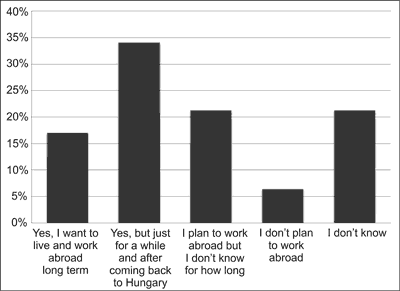
Fig. 2. Planning to work abroad.
(n = 48)
Significant correlation was found between the intention to work and the intention to get foreign work experience as an intern. The correlation outlines a group of students with international mobility. Gaining actual internship experience abroad will on the one hand reinforce later mobility among students, while the weight of international social capital for career planning dramatically increases.

Fig. 3. Are you planning to have work experience as an intern?
(n = 48)
Obviously, no general conclusions can be drawn from the students” desire to emigrate regarding the extent of real migration in the future. One can only assume that the responses were partially generated by other influences and it is also worth noting that the young generation of nursing students is characterized by a completely different value orientation and levels of openness to international mobility then do practicing nurses. The phenomenon, however, is interesting because the test was performed first in September 2011, while we also analyzed previous results gained in the framework of the Semmelweis University Graduate Career Tracking Study. All previous research shows that the will to migrate is increasing dramatically among students.
Analyzing the results highlighted many results that could explain high levels for the intentions but can hardly account for their exponential growth.
Thus we had to assume that the effects amplify each other somehow, and that the network plays the role of a channel of transmission.
In our second survey we asked already practicing nurses how many migrant nurses they knew who have already left the country. Most responses reflected one or two such acquaintances. Taking the results of the network theory as our starting point and supposing that the frequency of contacts may increase the number of elements in the network dramatically as well as their interaction, in the analysis we only tried to describe the characteristics of respondents who mentioned at least 3 or more acquaintances.
The age group variable function revealed that the largest migration network corresponds to between 30-40 years of age, but that the 40-50 age groups also has a substantial network of contacts among emigrants (fig. 4).
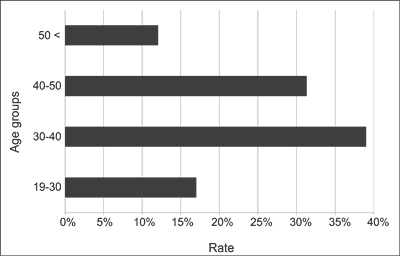
Fig. 4. Nurses with more than 3 migrant links by age group.
(n= 411)
If we examine these connections further, it becomes apparent that the migrants reported as indirect links or direct links in the responses are practically identical with only slight differences. Of this, we can also draw the conclusion that information concerning migrants is more and more received through the nurses” personal network. Therefore, the network can be expected to show strong connections.
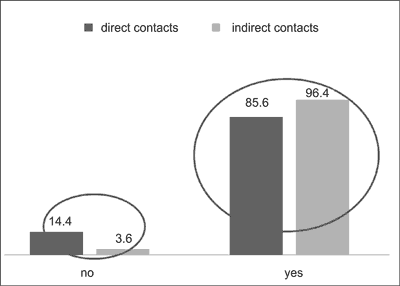
Fig. 5. Do you have any link to the migrants from your network?
(n = 411)
If we also consider the extent to which migration is an acceptable life path option for nurses in Hungary with strong migration network connections, we can unsurprisingly see that the process evidently enjoys acceptance (fig. 6). Furthermore, a strong majority of respondents, over 80 per cent might be personally involved in the process, which is further amplified by the strengthening of network connections.
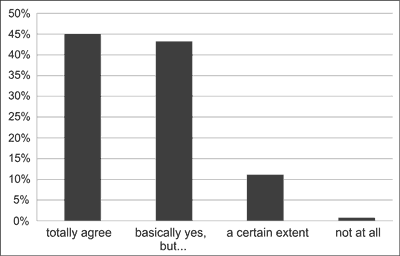
Fig. 6. Do you agree with the migration of nurses?
(n = 411)
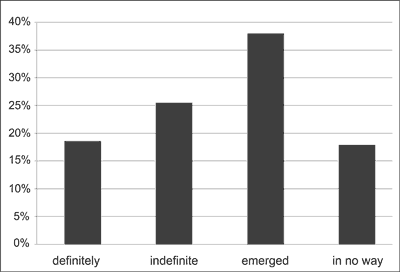
Fig. 7. Are you thinking of moving abroad?
(n = 411)
The strength of connections is also shown by the fact that 64 per cent of respondents and migrants worked in the same institution. This validates our assumption to the effect that direct contacts have a strong binding force. When a nurse is considering migration, they are likely to find help in just one step, (fig. 8) whereas the satisfaction of migrants concerning the host country and their new life there further contributes to strengthening the bonds of the network (fig. 9).

Fig. 8. Where were the colleagues working before leaving?*
(n = 182)

Fig. 9. Are the migrants expectations fulfilled?
(n = 411)
CONCLUSIONs
518 official certificates were issued for nurses in the Health Care Certification and Public Administration Office (EEKH) in 2012 compared to 314 certificate requests in 2011 (fig. 10).
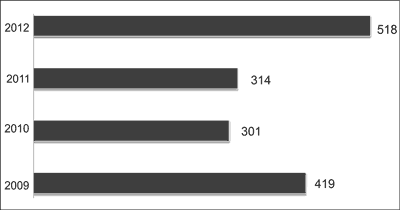
Fig. 10. The number of nurses who applied for official certificate to work abrodad.
However, the actual number of nurses and health care professionals leaving the sector is probably much higher. Qualified nurses often carry out undeclared work abroad as nurses or caretakers, or are registered as family members. After they learn the language and adjust themselves to the given country they register for employment at the organizations for nurses. Those who receive citizenship in the meantime in the host country will not be registered either back home.
If only 400-500 nurses leave, this is the equivalent of the complete nursing staff of a hospital in medium-sized town. The first migrants (about whom data is available) have been working abroad for 2-3 years, and one can go as far as saying that they are preparing the field for those who are still at home. They contact each other and take each other abroad to work, as employers in the host country ask already respected Hungarian employees to bring new fellow workers.
According to the EEKH, the younger age group between 30-40 years of age is the most daring. This is also apparent from the data of our survey. They can get a hold in the system abroad, can overcome difficulties easily and generally have a good time abroad.
International migration in itself is a process which can difficult to assess or survey. It nevertheless provides indispensable clues to reveal what paths and challenges society has in store in the future. What is certain is that the migration of health care professionals is becoming more and more prominent, and it causes increasingly concrete and tangible difficulties in social subsystems as well as indirectly in everyday life.
Our colleagues at the Semmelweis University Faculty of Health Sciences have already carried out several research projects and their synthesis might lead to the description of the migration trends of healthcare specialists. Four years ago, when Dr. István Vingender and his colleagues did a study about migration to work abroad, the number of those who predicted leaving the country for sure was the same as today. But the number of those who rejected the whole idea was far higher than nowadays (9).
My point is that the new method incorporating the rules of networking will contribute the following:
It provides an overview concerning the correlation between intended and realized migration and the “tipping point” between the two, which determines the decision to stay or to migrate.
The characteristic life events of the target group can be described at the network level.
It is possible to receive strategic information about professional and private networks among health care professionals, which might even be used to influence the direction of the migration process.
Migration of health care professionals has reached globally a critical level. International organizations mainly formulate classical recommendations which are less and less feasible, primarily on the level of national strategies. In contrast, the solution might be found on a smaller, local level, illuminated at times only by surveys of this type involving networks.
Factors of real influence are mostly based on harnessing the social and civil networks as well as exploiting cultural and social capital.
Readiness for mobility is a determining element when a decision about migration is taken: when somebody has to move, they will do so abroad, not done domestically.
The financial situation and income is only a segment but not an absolute determining point of international migration. The survey highlights the connections between certain values, differences and the embeddedness of the background of decision processes.
While exploring or analyzing the reasons for migration, no strategic documents or impact assessment were elaborated addressing the root causes. The two segments of research explore whether a critical level of migration has or has not been reached, and what might be the root causes thereof.
Piśmiennictwo
1. Hagen-Zanker J: Why Do People Migrate? A Review of the Theoretical Literature (January 2008). Maastrcht Graduate School of Governance Working Paper No. 2008/WP002. Available at SSRN: http://ssrn.com/abstract=1105657 or http://dx.doi.org/10.2139/ssrn.1105657. 2. Freeman M, Baumann A, Blythe J et al.: Migration: a concept analysis from a nursing perspective. J Adv Nurs 2012; 68(5): 1176-1186. 3. De Jong G, Fawcett J: Motivations for migration: an assessment and a value-expectancy research model. [In:] De Jong G, Gardner R (ed.): Migration Decision Making: Mutlidisciplinary Approaches to Microlevel Studies in Developed and Developing Countries. Pergamon Press, New York 1981; 13-58. 4. Illés S, Kincses Á: Migráció és cirkluláció. Statisztikai Szemle, 87. Évfolyam 7-8. szám. 5. Douglas M, García-Espańa F: The Social Process of International Migration. Science 1987; 237: 733-738. 6. Barabási AL: Linked: The New Science of Networks (Perseus, Cambridge, MA, 2002). 7. Barbara LB: Global Nurse Migration Today. J Adv Nurs 2008; 40(1): 20-25. 8. Boyd M: Family and personal networks in international migration: Recent developments and new agendas. International Migration Review 1989; 23(3): 638-670. 9. Vingender I, Mészáros J, Kis J: Migration Potential Of Hungarian Healthcare Professionals – Dynamics Of Attraction And Repulsion. European Journal of Mental Health 2009; 4,2: 195-219.









